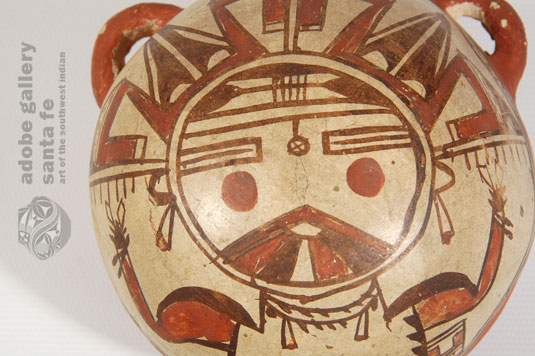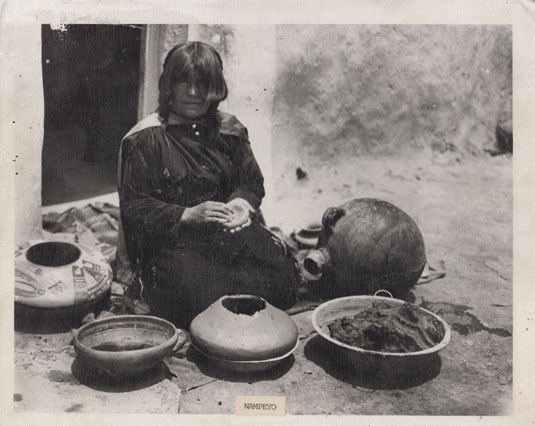Hopi Small Polychrome Pictorial Canteen by Nampeyo [SOLD]
+ Add to my watchlist Forward to Friend
- Category: Historic
- Origin: Hopi Pueblo, Hopituh Shi-nu-mu
- Medium: clay, pigment
- Size: 4-7/8 height x 4” width x 3-1/4” depth
- Item # 26070 SOLD
This small Hopi canteen by Nampeyo of Hano came to us from the estate of former Santa Fe collector and dealer, Marti Struever. It was in Marti’s personal collection. She identified it as a Polacca Polychrome by Nampeyo, circa 1890.
Dr. Edwin Wade previously provided us with a beautiful description of miniature canteens which we repeat here:
Among the most popular turn-of-the-20th century Hopi tourist pots was the miniature canteen. Unlike museum collectors who insisted on the utilitarian authenticity of the items they were acquiring, the early curio hunters were content with brightly designed non-functional mementos. It was better still if such objects were easily transportable. Consequently, trading posts and other Indian craft operators began by the close of the 19th century to instruct native artisans in the advantage of miniaturization.
At first this must have been confusing to the potters, since who could possibly want a bowl, jar, or canteen that was useless. Nevertheless, the potters rapidly adapted when they realized that these new consumers were content merely to look at and not employ such items.
The time benefit of making small jars and bowls is self-evident, but any canteen making, large or small, is labor intensive. Perfecting the domed surface of the vessel is taxing and requires the hand of a skilled potter. Nampeyo and her eldest daughter, Annie, were noted for their talent in the manufacture of such vessels, which frequently were sold at the Fred Harvey Hopi House at Grand Canyon National Park.
Nampeyo placed the pair of looped handles at the same plane as the upturned spout, all of which are in the lower third of the vessel body that is slipped in red pigment. The upper two thirds of the domed body is where Nampeyo displayed her artistic design of a Palhikmana Katsina in almost full perspective. Her face is at the center of the dome and an elaborate tableta fills the upper half of the area, with the katsina’s body filling in the lower half. She is provided with a traditional Hopi homespun manta, a double string of turquoise nuggets with jaclas as a necklace, and jaclas earrings. The katsina’s chin displays the traditional rainbow feature of that katsina.
Condition: this Hopi Small Polychrome Pictorial Canteen by Nampeyo is in excellent condition with no apparent repairs or touch-up paint.
Provenance: from the estate of former Santa Fe collector and dealer Marti Struever who was a devoted fan of Nampeyo.
Recommended Reading: Nampeyo, Hopi Potter: Her Artistry and Her Legacy by John Collins
Image: We are appreciative to Hopi-Tewa potter, Mark Tahbo, for sharing this photograph with us. The photograph was recently found in a burned out home at First Mesa. This image was later identified as having been taken on July 8, 1913, by photographer Joseph K. Dixon. It is part of the Wanamaker Collection of American Indian Photographs at the Mathers Museum of World Cultures, Indiana University, catalog #1962-08-3279.

- Category: Historic
- Origin: Hopi Pueblo, Hopituh Shi-nu-mu
- Medium: clay, pigment
- Size: 4-7/8 height x 4” width x 3-1/4” depth
- Item # 26070 SOLD




